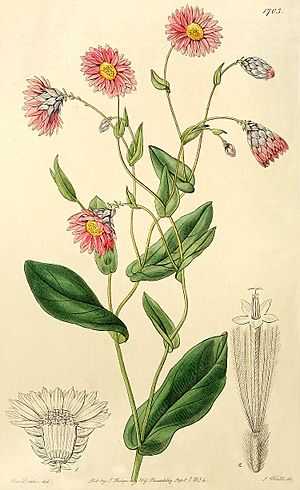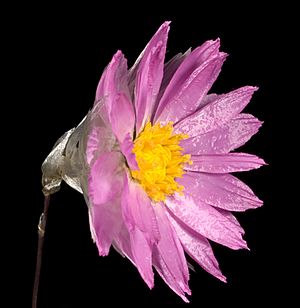Rhodanthe manglesii facts for kids
Quick facts for kids Rhodanthe manglesii |
|
|---|---|
 |
|
| Botanical illustration by Sarah Drake | |
 |
|
| Scientific classification | |
| Kingdom: | |
| (unranked): | |
| (unranked): | |
| (unranked): | |
| Order: | |
| Family: | |
| Tribe: |
Gnaphalieae
|
| Genus: |
Rhodanthe
|
| Species: |
R. manglesii
|
| Binomial name | |
| Rhodanthe manglesii |
|
| Synonyms | |
|
|
Rhodanthe manglesii is a beautiful little plant that grows in Western Australia. It's also known by fun names like pink sunray, silver bells, Australian strawflower, timeless rose, or Mangles everlasting. This plant was first brought to England in 1834. Seeds were collected by a person named James Mangles, which is why one of its common names is "Mangles everlasting."
Contents
What is the Pink Sunray?
The pink sunray is a type of herbaceous plant. This means it has soft stems, not woody ones like a tree. It grows upright and can be anywhere from 0.1 to 0.6 metres tall. Sometimes, you can see large areas covered in these plants, like a colourful carpet!
How Do Its Flowers Look?
The flowers of the pink sunray are quite special. Each flower head has a bright yellow centre. This centre is surrounded by pretty pink or white petals, which are actually called florets.
Before the flowers open, they look like little bells. These bell-shaped buds are made of shiny, silver-coloured, papery parts called bracts. They often hang downwards, or "nod," before blooming. In its natural home, you can see these flowers from August to October.
Where Does the Pink Sunray Grow?
This plant is native to Western Australia. It loves to grow in different types of soil. You can often find it in sandy, clayey, or loamy soils. These are common soil types found in its native habitat.
Who Discovered and Described It?
The Rhodanthe manglesii was first officially described in 1834. This was done by a botanist named John Lindley. His description was published in a book called the Botanical Register.
An amazing illustration of the plant was also included with the description. This beautiful drawing was created by an artist named Sarah Drake. Her artwork helped people see exactly what this new plant looked like.

